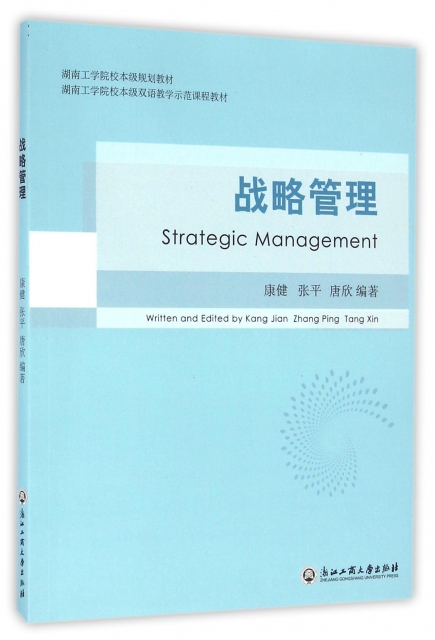| | | | 戰略管理(湖南工學院校本級雙語教學示範課程教材) | | 該商品所屬分類:管理 -> 企業管理 | | 【市場價】 | 412-598元 | | 【優惠價】 | 258-374元 | | 【介質】 | book | | 【ISBN】 | 9787517815334 | | 【折扣說明】 | 一次購物滿999元台幣免運費+贈品
一次購物滿2000元台幣95折+免運費+贈品
一次購物滿3000元台幣92折+免運費+贈品
一次購物滿4000元台幣88折+免運費+贈品
| | 【本期贈品】 | ①優質無紡布環保袋,做工棒!②品牌簽字筆 ③品牌手帕紙巾
|
|
| 版本 | 正版全新電子版PDF檔 | | 您已选择: | 正版全新 | 溫馨提示:如果有多種選項,請先選擇再點擊加入購物車。*. 電子圖書價格是0.69折,例如了得網價格是100元,電子書pdf的價格則是69元。
*. 購買電子書不支持貨到付款,購買時選擇atm或者超商、PayPal付款。付款後1-24小時內通過郵件傳輸給您。
*. 如果收到的電子書不滿意,可以聯絡我們退款。謝謝。 | | | |
| | 內容介紹 | |

-
出版社:浙江工商大學
-
ISBN:9787517815334
-
作者:編者:康健//張平//唐欣
-
頁數:182
-
出版日期:2016-02-01
-
印刷日期:2016-02-01
-
包裝:平裝
-
開本:16開
-
版次:1
-
印次:1
-
字數:306千字
-
康健、張平、唐欣編著的《戰略管理(湖南工學
院校本級雙語教學示範課程教材)》闡述了企業戰略
管理的基本理論和概念,說明了企業使命制訂、願景
闡述、內外部分析、戰略制訂、戰略執行、戰略控制
等模塊的內容,本書主要使用英文進行內容闡述,重
要的關鍵點和核心概念采用中英文對照的方式進行說
明。
-
Chapter 1 Introduction to Strategic Management
1.1 Strategic Competitiveness
1.2 The Global Economy
1.3 Vision
1.4 Mission
1.5 Strategic Management Process
1.6 Developing a Strategic Vision and Mission
1.7 Setting Objectives
1.8 Crafting a Strategy
1.9 Implementing and Executing a Strategy
1.10 Approaches to Performing the Strategy-Making Task
1.11 Strategic Management Principle
Chapter 2 The External Environment
2.1 The General, Industry, and Competitor Environments
2.2 External Environmental Analysis
2.3 Scanning
2.4 Monitoring
2.5 Industry Environment Analysis
2.6 Threat of New Entrants
2.7 Bargaining Power of Buyers
2.8 Threat of Substitute Products
2.9 Strategic Groups
2.10 Ethical Considerations
2.11 Rivalry Among Competing Sellers
Chapter 3 The Internal Environment
3.1 Analyzing the Internal Organization
3.2 Creating Value
3.3 Resources, Capabilities, and Core Competencies
3.4 Resources
3.5 Tangible Resources
3.6 Intangible Resources
3.7 Capabilities
3.8 Core Competencies
3.9 The Four Criteria of Sustainable Competitive Advantage
3.10 Value Chain Analysis
3.11 Outsourcing
3.12 Analyzing Driving Forces
Chapter 4 Evaluating Resources and Competitive Capabilities
4.1 A Model of Competitive Rivalry
4.2 Competitor Analysis
4.3 Resource Similarity
4.4 Competitive Rivalry
4.5 Strategic and Tactical Actions
4.6 Competitive Dynamics
4.7 Slow-Cycle Markets
4.8 Fast-Cycle Markets
4.9 Company Situation Analysis
4.10 Typical Company Value Chain
4.11 How Strong the Company's Competitive Position Is
Chapter 5 Business-Level Strategies
5.1 Customers: Their Relationship with Business-Level Strategies
5.2 The Purpose of Business-Level Strategies
5.3 Types of Business-Level Strategies
5.4 Cost Leadership Strategies
5.5 Differentiation Strategies
5.6 Focus Strategies
5.7 Focused Cost Leadership Strategies
5.8 Competitive Risks of Focus Strategies
5.9 Integrated Cost Leadership/Differentiation Strategies
5.10 Levels of Diversification
5.11 Low Levels of Diversification
5.12 Reasons for Diversification
5.13 Value-Creating Diversification: Related Constrained and Related Linked Diversification
Chapter 6 Functional Strategies and Strategic Choices
6.1 Operational Relatedness: Sharing Activities
6.2 Market Power
6.3 Simultaneous Operational Relatedness and Corporate Relatedness
6.4 Value-Neutral Diversification: Incentives and Resources
6.5 Resources and Diversification
6.6 Value-Reducing Diversification: Managerial Motives to Diversify
6.7 The Popularity of Merger and Acquisition Strategies
6.8 Increased Market Power
6.9 Cost of New Product Development and Increased Speed to Market
6.10 Learning and Developing New Capabilities
6.11 Managers Overly Focused on Acquisitions
6.12 Three Basic Benefits of International Strategies
6.13 International Strategies
6.14 International Business-Level Strategies
6.15 Global Strategy
6.16 Acquisitions
6.17 Risk of Best-Cost Provider Strategies
6.18 Merger and Acquisition Strategies
6.19 Unbundling and Outsourcing Strategies
6.20 Offensive Strategies and Competitive Advantage
6.21 First-Mover Advantages
Chapter 7 Strategy Implementation
7.1 Implementing Internal Innovations
7.2 Facilitating Integration and Innovation
7.3 Innovation Through Cooperative Strategies
7.4 Organizational Structure and Controls
7.5 Functional Structure
7.6 The Role of Top-Level Managers
7.7 Top Management Teams
7.8 Managerial Succession
7.9 Sustaining an Effective Organizational Culture
7.10 Establishing Balanced Organizational Controls
7.11 Entrepreneurship and Entrepreneurial Opportunities
7.12 Innovation
7.13 Internal Innovation
7.14 Incremental and Radical Innovation
7.15 Autonomous Strategic Behavior
7.16 Why the World Economy Is Globalizing
7.17 Multi-domestic Strategy Maximizes Local Responsiveness
7.18 Locating Activities to Build a Global Competitive Advantage
7.19 What Profit Sanctuaries Are
7.20 Advantages and Disadvantages of the Four Strategies
7.21 New Business Model for the Internet Economy
7.22 Internet Strategies for Traditional Businesses
7.23 Tailoring Strategy to Fit Specific Industry Situations
7.24 Competitive Advantage in Diversified Companies
7.25 Sales and Marketing Fits
7.26 What Unrelated Diversification Is
7.27 How Broadly a Company Should Diversify
7.28 Turnaround Strategies
Chapter 8 Strategic Evaluation and Control
8.1 Product Diversification as an Example of an Agency Problem
8.2 Ownership Concentration
8.3 Enhancing the Effectiveness of the Board of Directors
8.4 Evaluating the Strategy of Diversified Companies
8.5 How Corporate Strategies Form
8.6 Building Core Competencies and Competitive Capabilities
8.7 What the Goals of the Strategy Implementing-Executing Process Are
8.8 Key Traits to Building Core Competencies
8.9 Instituting Best Practices and Installing Support Systems
8.10 What Total Quality Management Is
8.11 What Areas Information Systems Should Address
8.12 Guidelines for Designing an Effective Compensation System
後記
| | |
| | | | |
|




